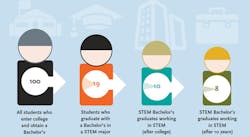A 2011 Pew research study authored by Russell Heimlich forecast that for the next 19 years, 10,000 Baby Boomers will reach age 65 every day. “The [aging] of this huge cohort of Americans (26% of the total U.S. population are “Baby Boomers”) will dramatically change the composition of the country,” it noted. “Currently, just 13% of Americans are ages 65 and older. By 2030, when all members of the Baby Boom generation have reached that age, fully 18% of the nation will be at least that age, according to Pew Research Center population projections.”
Obviously, engineers will make up a small percentage of the 10,000 retirees per day, but in 19 years that could still put a significant dent in the number of employed U.S. engineers. And as more retire, who will replace them?
A 2013 report by Aberdeen Group asserts that there will be a limited number of engineers and additional challenges faced by manufacturers. As the supply of engineers goes down, the price it takes to attract this talent will increase: “This causes trouble for many companies; over half of those surveyed indicated a lack of willingness to pay enough for top talent. This means these companies will have to resort to hiring freshly graduated engineers. While it is true new graduates are cheaper to acquire, they are also unproven and may lack the experience or maturity to contribute immediately."
If more young engineers are employed, will they have the necessary knowledge to contribute to the company they work for? Certainly, it will take a few years for young engineers to “get up to speed.” Also, can the U.S. education system teach enough young engineers the appropriate subjects to support their indoctrination into the real world of engineering?
Answering some of the above questions is a 2011 report by Georgetown University’s Center for Education of the Workforce authored by Anthony P. Carnevale, Nicole Smith, and Michelle Melton, entitled STEM. The report notes that Science, Technology, Engineering, and Mathematics (STEM) occupations are critical to the U.S.’s continued economic competitiveness, owing to their direct ties to innovation, economic growth, and productivity—even though they will only be 5% of all jobs in the U.S. economy by 2018. And virtually all engineers have a STEM background.
However, the Georgetown report said that we are not producing enough STEM workers to compete successfully in the global economy: “We find that this concern is warranted—but not for the reasons traditionally claimed. High and rising wage premiums are being paid to these workers in spite of the increasing global supply. This suggests that the demand for these workers is not being met. Indeed, with the exception of some PhD-level researchers in academia, the demand for workers in STEM occupations is increasing at every education level.
“The STEM supply problem goes beyond the need for more professional scientists, engineers, and mathematicians. We also need more qualified technicians and skilled STEM workers in Advanced Manufacturing, Utilities and Transportation, Mining, and other technology-driven industries. Innovation and technology change have led to demand for STEM competencies beyond traditional STEM occupations. Previously, STEM work had been concentrated among an elite few workers. Today, competencies necessary for innovation are scattered across a wider swath of the economy.”
STEM competencies are needed in a broader reach of occupations, and their use is growing. What’s more, people within these occupations who use STEM competencies most intensely are earning significantly more than those who are not. The concern for STEM shortages tends to focus on the possibility of an insufficient supply of these workers, but the deeper problem is a broader scarcity of workers with basic STEM competencies across the entire economy. Demand for the core competencies is far greater than the 5% traditional STEM employment share suggests, and stretches across the entire U.S. job market—touching virtually every industry. Since 1980, the number of workers with high levels of core STEM competencies has increased by almost 60%. Further, in all but two occupational clusters, the rate of growth in demand for these core STEM competencies has increased at far greater rates than the growth in employment.
The Georgetown report says that the intensifying demand for STEM competencies contributes to diversion, a process through which both students and workers steer away from STEM degrees and careers for numerous reasons. “Diversion is both voluntary and involuntary,” it says, “and students and workers divert at various points throughout K-12 and post-secondary education as well as in the workforce.
“The diversion of native-born STEM talent into non-STEM educational and career pathways will continue and likely accelerate in the future. This diversion of native-born STEM talent may contribute to an increasing reliance on foreign-born STEM talent among American employers.”
The Georgetown report also notes that we have been using a strategy of relying on foreign-born workers to plug the leaks in our STEM pipeline. Foreign-born workers account for 17% of all STEM workers, compared with 12 % in the labor force as a whole. In some STEM occupations, foreign-born workers make up even more of the STEM labor force—for example, 25% of all physical scientists are foreign-born. Foreign-born workers often start as foreign-born students, who then stay in the United States to work. Looking at the statistics:
- 44% of students on F-1 student visas were here to study STEM in 2008.
- 63% of foreign-born students in STEM fields are in graduate programs.
- 59% of PhD recipients in engineering fields in 2009 were foreign-born.
- The share of the foreign-born workforce in STEM has more than doubled in the last 60 years, from 7% in 1950 to 16% in 2000 to 17% in 2008.
- Increasingly, foreign-born STEM workers are from Asia. 59% of foreign-labor workers in STEM occupations were from Asia in 2000.
- Foreign-born STEM workers are more likely than other foreign-born workers to become naturalized citizens.
We are relying heavily on the foreign-born workforce to fill our STEM jobs. Whether we can continue to employ this strategy as wages become more competitive in other countries remains an open question. It is unlikely that we will continue to be able to successfully compete for the top international talent.
This report points out that the growing demand for STEM talent allows and encourages the diversion of students and workers with STEM competencies. However, STEM competency changes and takes a toll on those involved. The graphic above (taken from the Georgetown report) shows the regression jobs for STEM bachelor’s graduates after college.
More Education
The Georgetown report also says that by 2018, the majority of STEM jobs will require some form of post-secondary education or training. Close to two-thirds of STEM job openings will be for those with Bachelor’s degrees and above (65%). Roughly 35% of the STEM workforce will be comprised of those with sub-baccalaureate training.
STEM book knowledge is not enough. Other skills are necessary, particularly in solving problems. You can’t teach some of these capabilities, but they must be inherent in the individual. The Georgetown report lists examples of these skills:
- Mathematics: Using mathematics to solve problems.
- Science: Using scientific rules and methods to solve problems.
- Critical thinking: Using logic and reasoning to identify the strengths and weaknesses of alternative solutions, conclusions, or approaches to problems.
- Active learning: Understanding the implications of new information for both current and future problem-solving and decision-making.
- Complex problem solving: Identifying complex problems and reviewing related information to develop and evaluate options and implement solutions.
- Operations analysis: Analyzing needs and product requirements to create a design.
- Technology design: Generating or adapting equipment and technology to serve user needs.
- Equipment selection: Determining the kind of tools and equipment needed to do a job.
- Programming: Writing computer programs for various purposes.
- Quality control analysis: Conducting tests and inspections of products, services, or processes to evaluate quality or performance.
- Operations monitoring: Watching gauges, dials, or other indicators to make sure a machine is working properly.
- Operation and control: Controlling operations of equipment or systems.
- Equipment maintenance: Performing routine maintenance on equipment and determining when and what kind of maintenance is needed.
- Troubleshooting: Determining causes of operating errors and deciding what to do about it.
- Repairing: Repairing machines or systems using the needed tools.
- Systems analysis: Determining how a system should work and how changes in conditions, operations, and the environment will affect outcomes.
- Systems evaluation: Identifying measures or indicators of system performance and the actions needed to improve or correct performance, relative to the goals of the system.
Also going beyond book knowledge are personal abilities associated with STEM occupations, according to the Georgetown report. Usually, these can’t be taught because they depend on the individual. Some traits are intuitive, while other must be learned.
- Problem sensitivity: The ability to tell when something is wrong or is likely to go wrong. It does not involve solving the problem—only recognizing that there is one.
- Deductive reasoning: The ability to apply general rules to specific problems.
- Inductive reasoning: The ability to combine pieces of information to form general rules or conclusions (includes finding a relationship among seemingly unrelated events).
- Mathematical reasoning: The ability to choose the right mathematical methods or formulas to solve a problem.
Many of these capabilities are acquired as a young engineer gets experience in the real world of engineering. New graduates have to go through a learning curve to become an experienced, innovative, and productive engineer.

